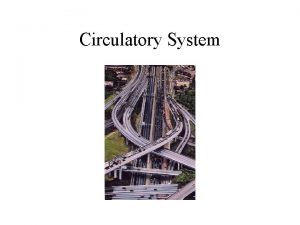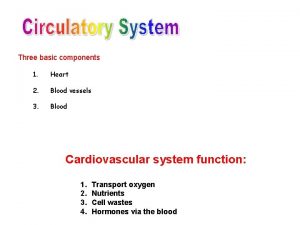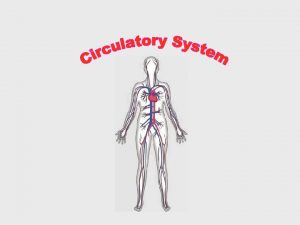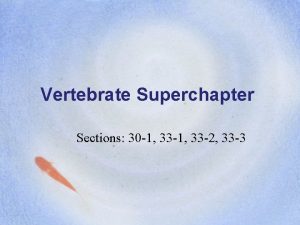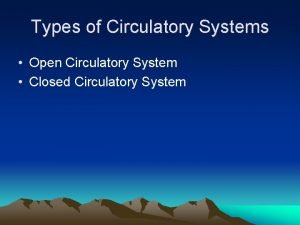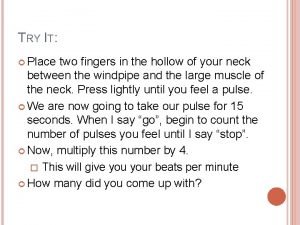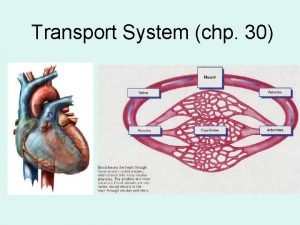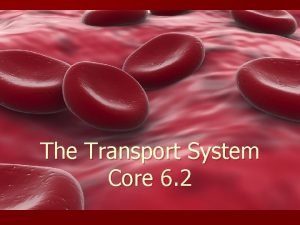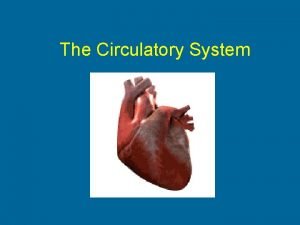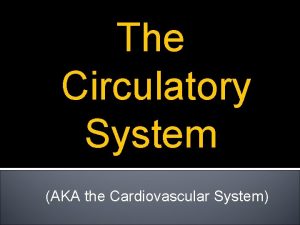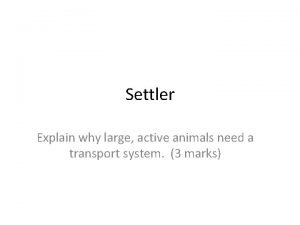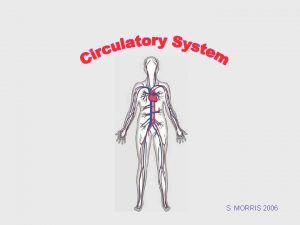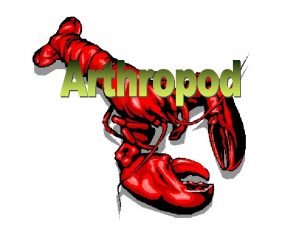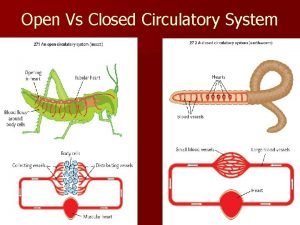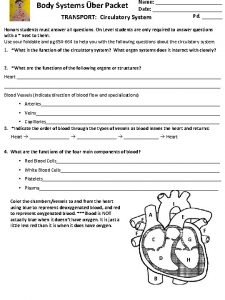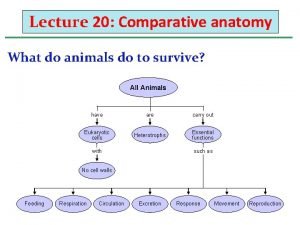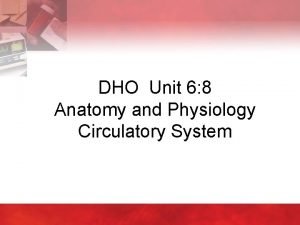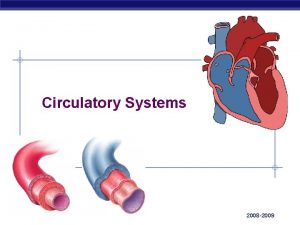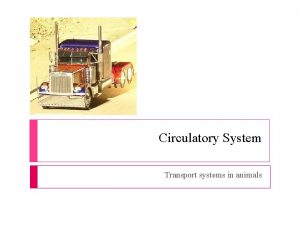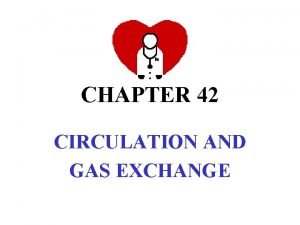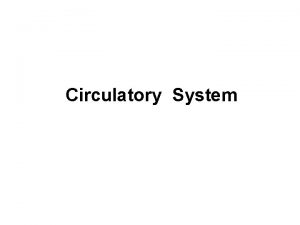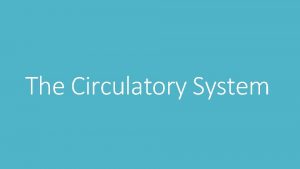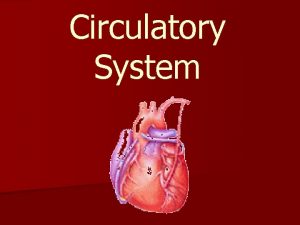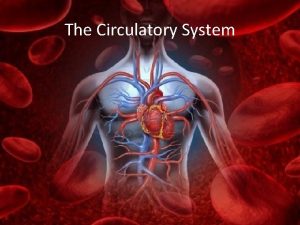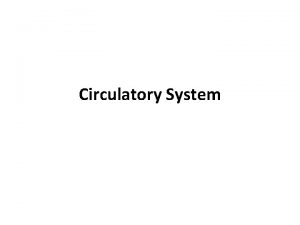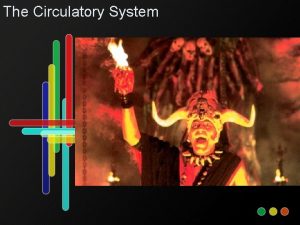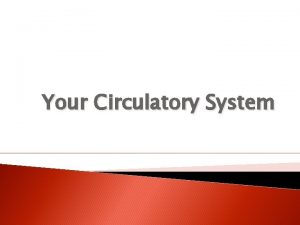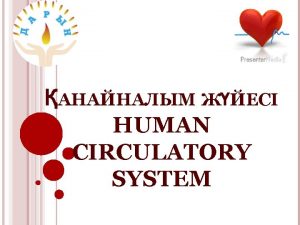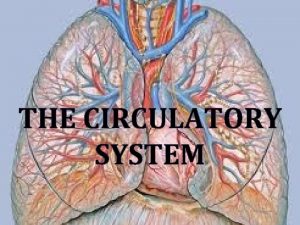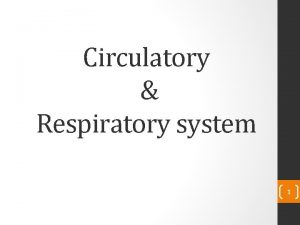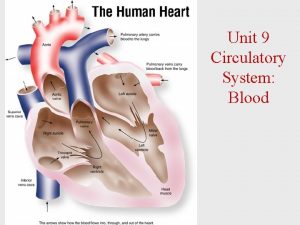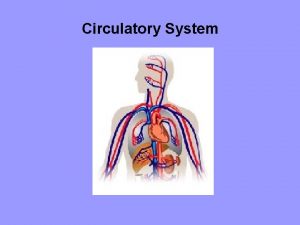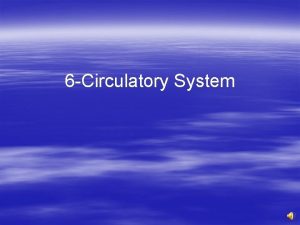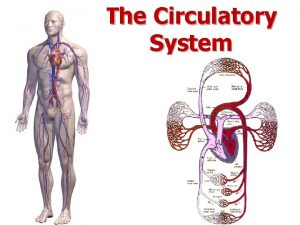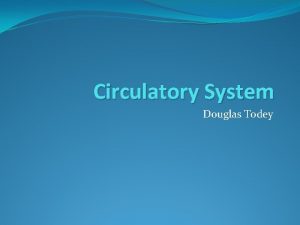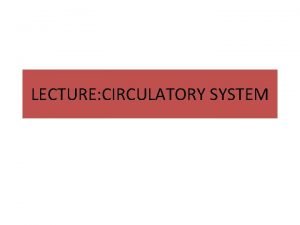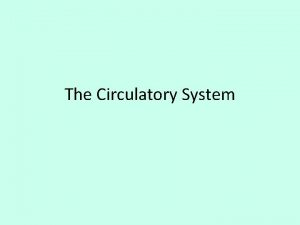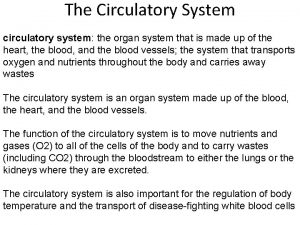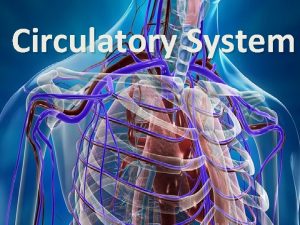The Circulatory System Functions of the Circulatory System































- Slides: 31

The Circulatory System

Functions of the Circulatory System Brings blood containing oxygen and nutrients to cells l Transports CO 2 and other wastes away from cells l Fights infection l Regulates body temperature l

Circulatory System Components l Heart l Blood l Vessels Arteries l Veins l Capillaries l

The Heart l l l A muscular pump Moves blood through the body Has four chambers l Aorta Superior vena cava Left pulmonary artery l Left atrium Right pulmonary veins Left pulmonary veins Right atrium Inferior vena cava Right ventricle Left ventricle Divided into right and left halves Made up of cardiac muscle cells

Structures of the Heart Chambers l Atria- (2) upper chambers l l Left atrium Aortic valve Right atrium Ventricles- (2) lower chambers l l Thin walled Receive blood from veins Send blood to ventricles Pulmonary valve Thick walled Receive blood from atria Pump blood out through arteries Mitral valve Left ventricle Tricuspid valve Septum Right ventricle Septum l Wall that divides heart into right and left halves

Pathway of Circulation l Oxygen-poor blood draining from the body through veins into the superior and inferior vena cava flows to the right atrium, through the tricuspid valve, and into the right ventricle. l As the right ventricle contracts, oxygen-poor blood passes through the pulmonary valve into the pulmonary arteries and on to the lungs to receive oxygen.

Pathway of Circulation l l l Oxygen-rich blood from the lungs enters the heart through the pulmonary veins, passing into the left atrium. Then through the mitral valve to the left ventricle. Contraction of the left ventricle forces blood through the aortic valve into the aorta. Various arteries branch off from the aorta to supply blood to all parts of the body.

Pathway of Circulation Nutrients pass into tissues Waste products filter back Blood pumped out of heart into arteries, which branch into smaller and smaller vessels until blood flows into capillaries l Arteries branch into smaller and smaller vessels (arterioles). l They eventually become capillaries, which supply blood to all body parts. l Capillaries merge and join veins to carry blood back to the heart. Blood returns to the heart through the veins Heart Capillary network

Blood Vessels l Form a closed circuit of tubes that carry blood throughout the body l Laid end to end, the blood vessels in an average human body will stretch approximately 62, 000 miles…… 2. 5 times around the earth

Blood Vessels l Arteries l Receive blood from ventricles l Take blood away from the heart l Usually carry oxygenated blood l Aorta is the largest artery

Blood Vessels l Veins Transport blood away from capillaries l Carry blood toward heart l Usually carry de-oxygenated blood l Vena cava is the largest vein l

Blood Vessels l Capillaries Smallest of blood vessels l Only one cell thick (epithelial cell) l Connect arteries to veins l Bring oxygen and nutrients to cells l Removes CO 2, nd other wastes from cells l Where blood is under low pressure and moving slowly l

Blood Pressure Blood pressure refers to the force exerted by circulating blood on the walls of blood vessels The pressure of the circulating blood decreases as blood moves through arteries, arterioles, capillaries, venules, and veins

Blood Pressure l Blood pressure is most commonly measured via a sphygmomanometer (blood pressure cuff) l Average blood pressure for an adult is 120/80

Pulse l l A person's pulse is the throbbing of their arteries as an effect of the pressure waves (heart beat) Pulse is used to denote the frequency of the heart beat l l l It can be felt at neck, wrist, and other places Pulse is usually measured in beats per minute. In most people, the pulse is an accurate measure of heart rate.

Blood l A circulating connective tissue consisting of several types of cells suspended in a fluid called plasma.

Blood l Functions l Supply of blood: oxygen l Supply nutrients l Removal of wastes

Blood l l What percent of your body is blood? 8% How much blood do we contain? l l l On average 4 -6 liters We contain about a pint of blood for every 15 pounds of body weight Composition of Blood: l l What percent of your blood is cellular? 45% What percent of your blood is plasma? 55%

Blood l What is plasma? A clear, straw colored fluid l What percent of plasma is water? 90% l What’s in plasma? l Plasma (55% of whole blood) Buffy coat leukocytes and platelets (<1% of whole blood) Erythrocytes (45% of whole blood) Formed elements l l l Dissolved gasses Vitamins Minerals Salts Nutrients Layering of blood components in a centrifuged blood sample

Blood l l The cellular components are: l red blood cells l white blood cells l platelets Blood cells are formed in bone marrow

Blood l Red Blood Cell Characteristics l Life span about 120 days l 5 billion/1 m. L of blood = most numerous l Are very small

Blood l White Blood Cell Characteristics Protect body against infection l Life span varies (3 days-a few months) l 7, 000/1 m. L of blood l Numbers increase if infection is present l Larger than red blood cells l

Circulatory System Disorders Heart Disease l Risk factors l l l l l Older age Male Cigarette smoking High cholesterol Diabetes Stress Obesity Family history Little to no exercise High blood pressure Quitting smoking, a healthy diet and exercise may reduce your risk of heart disease Plaque in coronary artery

Circulatory System Disorders Atherosclerosis l l Fatty deposits called plaque build up in the arteries This causes: l Blockage in artery l Less flexible vessels l High Blood Pressure

Circulatory System Disorders Hypertension l High Blood Pressure Makes the heart and blood vessels work harder Increases the chance of heart disease, heart attack or stroke

Circulatory System Disorders Heart Attack acute myocardial infarction l Interruption of oxygen supply to the heart l Causes death of the heart muscle l Leading cause of death in both men and women l Coronary Blockage

Circulatory System Disorders Heart Attack l Symptoms l l l l l Chest pain Squeezing or heavy pressure on chest Pain that radiates down left shoulder and arm Shortness of breath Nausea or vomiting Anxiety or Fainting Lightheadedness - dizziness Palpitations (feeling like your heart is beating too fast) Sweating, which may be extreme

Circulatory System Disorders Stroke Interruption of oxygen supply to the brain l Caused by: l A clot in an artery in the brain l Breakage of an artery in the brain l l Causes brain cells to be deprived of oxygen and die

Circulatory System Disorders Hemorrhage l l Hemorrhage is the medical term for bleeding - the loss of blood from the body Hemorrhage generally becomes dangerous, or even fatal, when it causes low blood volume or low blood pressure. l Hematoma- a collection of blood due to internal bleeding Gingival Hemorrhage

Circulatory System Disorders Hem philia l A rare inherited bleeding disorder in which the blood does not clot normally l The person is missing or has low levels of certain proteins in the blood called clotting factors Usually occurs only in males They suffer prolonged bleeding even with minor injuries l l Swelling in left knee joint due to spontaneous bleeding

Circulatory System Disorders Anemia l l Very few red blood cells Body doesn’t get enough oxygen Most common disorder of the red blood cells, affecting ~3. 5 million Americans A person with anemia will feel tired, weak, breathless, and dizzy l They may have a pale complexion, increased heart rate, low blood pressure, and difficulty concentrating l Severity changes
 Main function of the circulatory system
Main function of the circulatory system Pericardiu
Pericardiu Digestive system respiratory system and circulatory system
Digestive system respiratory system and circulatory system How respiratory system work with circulatory system
How respiratory system work with circulatory system Circulatory system and respiratory system work together
Circulatory system and respiratory system work together Circulatory system steps in order
Circulatory system steps in order Single loop circulatory system
Single loop circulatory system Heart fish
Heart fish Circulatory system of clams
Circulatory system of clams Horse heart
Horse heart Veinioles
Veinioles Closed circulatory system
Closed circulatory system Jobs of the circulatory system
Jobs of the circulatory system 3 parts of the circulatory system
3 parts of the circulatory system Double circulatory system
Double circulatory system How circulatory system work
How circulatory system work What makes up the circulatory system
What makes up the circulatory system The actual exchange of gases occurs at the site of the
The actual exchange of gases occurs at the site of the Single vs double circulatory system
Single vs double circulatory system Tagma
Tagma Arthropoda phylogeny
Arthropoda phylogeny Single vs double circulatory system
Single vs double circulatory system Circulatory system foldable
Circulatory system foldable Invertebrate circulatory system
Invertebrate circulatory system Fetal pig phylum
Fetal pig phylum Unit 6:8 circulatory system
Unit 6:8 circulatory system Open circulatory system
Open circulatory system Open circulatory system
Open circulatory system Main function of the circulatory system
Main function of the circulatory system Arthropods circulatory system
Arthropods circulatory system Difference between open and closed circulatory system
Difference between open and closed circulatory system Chapter 34 circulation in humans concept mapping answer key
Chapter 34 circulation in humans concept mapping answer key
